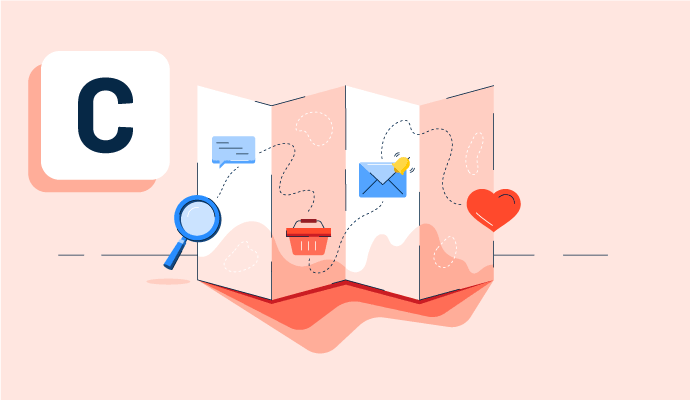What is a customer journey map?
A customer journey map (CJM) is a visual representation of a customer’s touch points when interacting with a company or a brand. A CJM includes every step along the buyer’s path, from initial awareness to post-purchase surveys.
Customer journey maps help businesses understand and improve the customer experience (CX). By mapping out the customer journey, companies find insights into their buyers’ goals and pain points. Then, they adjust their strategy to improve customer satisfaction.
Customer journey mapping software helps marketers develop dynamic visualizations of the customer’s journey across multiple channels. These platforms offer templates to simplify the creation process and facilitate collaboration between multiple stakeholders.
Types of customer journey maps
A marketing or product team’s goals influence the type of customer journey map they create. Some common types of customer journey maps include:
- Current-state maps, the standard CJM, depict customers' feelings each time they interact with a company or its products or services, including pain points.
- Future-state maps explore the ideal future customer experience and help companies determine where to make improvements, like adding a section on the homepage or introducing chatbot to answer live questions.
- Day-in-the-life maps look at how a customer thinks, behaves, and interacts with a product within the context of their day. They give organizations a lens of empathy and real world practicality.
- Empathy maps dive deep into a buyer’s mental and emotional state and motivations. Companies think about a typical buyer or ideal customer persona (ICP) and brainstorm what that person thinks, feels, does, and says. These maps help brands put themselves in their customers’ shoes and create a sense of empathy.
- Persona-based maps represent a customer’s experience at each touchpoint. However, the company creates a different map for each ICP they target.
Benefits of a customer journey map
As a visual representation of the customer journey, CJMs help organizations develop practical solutions to improve the customer and product experience. Specifically, a customer journey map helps a company:
- Boost customer satisfaction. Because CJMs provide a detailed look into customer motivations, thoughts, and feelings, organizations better understand and empathize with their customers. This empathy helps them alleviate pain points and create more satisfaction in the customer experience.
- Improve customer loyalty and retention rates. As companies work to use their CJMs to improve the experience, customers discover more pleasure at each touchpoint. Over time, these positive feelings lead to more loyalty and higher retention rates.
- Market and communicate more effectively. Customer journey maps give marketers a window into exactly what the customer is thinking on their path to purchase, which helps identify the best messages and channels to meet prospects where they are.
- Create better products and services. Product teams use customer journey maps to determine where and when to introduce new features based on customers’ needs. For example, insights from a day-in-the-life CJM might help app developers realize they need push notifications or reminders.
- Hone their competitive advantage. In a crowded marketplace with many brands offering similar products or services, a company can use customer experience as a selling point. This helps acquire new customers and increase revenue.
Customer journey map best practices
Creating a customer journey map improves the customer experience. For best results, companies need to follow these practices to ensure the map accurately represents the CJM.
- Define the persona. No matter which type of customer journey map an organization creates, it needs to start with a clear user or customer persona. Building a well-developed persona, a fictional profile of a potential buyer, is a prerequisite to the CJM. This persona helps companies envision the buyer as a real person rather than a generic representation.
- Identify all touchpoints. Companies should take the time to brainstorm all the touchpoints a customer may have with their brand or product, both online and offline. For example, buyers may see a social media ad, check out a product page on the company’s website, and visit an in-person store.
- Gather feedback. The only way to know what customers think is to ask them. Companies can gather these insights from feedback widgets on their website, surveys, or user interviews. Then, these insights can help teams validate or challenge their currently held views about the customer journey.
- Try color-coding or icons. Visual storytelling makes a customer journey map clear and engaging. Teams can use images and icons to make the map easy to understand. Color coding or emoticons can show a customer’s emotional state at each touchpoint.
Learn more about how to create a customer journey map.

Kelly Fiorini
Kelly Fiorini is a freelance writer for G2. After ten years as a teacher, Kelly now creates content for mostly B2B SaaS clients. In her free time, she’s usually reading, spilling coffee, walking her dogs, and trying to keep her plants alive. Kelly received her Bachelor of Arts in English from the University of Notre Dame and her Master of Arts in Teaching from the University of Louisville.

